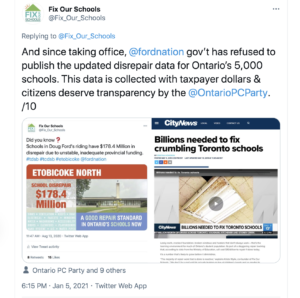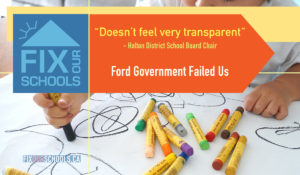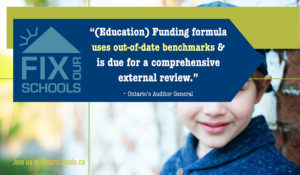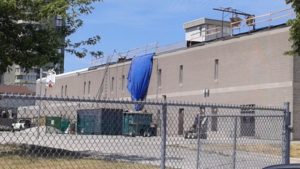What is the Plan for September Premier Ford?
Ontario parents, students, teachers and education workers continue to wait for the Ford government to release a well-funded, research-based, comprehensive plan for September that prioritizes Ontario’s children, their learning and their mental health.
Meanwhile, news is surfacing about the concerning impact of the pandemic and school closures on Ontario’s children. In a July 8, 2021 Toronto Star article entitled, “Very, very concerning: Pandemic taking heavy toll on children’s mental health, Sick Kids study shows”, Dr. Catherine Birken, a senior scientist and pediatrician at Sick Kids, states that for September, she hopes “there will be a heightened focus on in-person learning that includes the return of extracurricular activities and other support programs, including mental health services, while reducing disruptions to schooling.”
Amidst the frustrating wait for a back-to-school plan from the provincial government and this worrisome news about Ontario children’s mental health, Fix Our Schools was at least pleased to see the TDSB, Canada’s largest school board, carry on its commitment to transparency and advocacy.
“@tdsb schools are underfunded and have been for many years. The Board’s repairs backlog was approximately $3.7 billion as of May 2021. For the 2021-2022 school year, the Ministry allocated $275 million to the TDSB, well short of its repairs backlog.” https://t.co/hrudxIWMiY
— Shelley Laskin (@shelleylaskin) July 8, 2021
TDSB Continues its Commitment to Transparency and Advocacy
Back in August, 2016, the Toronto District School Board (TDSB) took a leadership position in transparency. Working with Fix Our Schools, the TDSB became the first school board to publicly release disrepair details on a school-by-school basis. Even though the provincial government had been collecting this school disrepair data for years, the Ministry of Education had never publicly released this data, so back in August 2016, Fix Our Schools was pleased to see the Ministry of Education follow the TDSB’s lead in transparency and release disrepair details for all Ontario schools a few days after the TDSB. We had had been calling for transparency on disrepair data, believing that transparency was critical to acknowledging the magnitude of the problem of disrepair in Ontario’s schools and then to move to finding solutions.
Thankfully, the TDSB has maintained its commitment to regularly updating and publicly sharing the disrepair data for its 588 schools. Fix Our Schools commends the TDSB for this commitment to transparency and was pleased to read the TDSB media release on July 8, 2021, with updated disrepair data for every TDSB school. 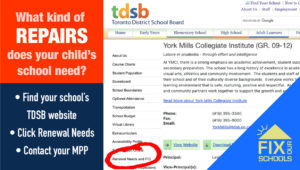
In conjunction with reviewing the detailed data on TDSB school disrepair, you may find our 2017 blog entitled, 10 Things you Need to Know About Your School’s Repair Backlog to be informative. It is an “oldie but a goodie” – and sadly, still very relevant. In addition, the TDSB media release on July 8, 2021 clearly outlined that:
- Our provincial government is responsible for all funding for public education and schools, and that TDSB schools have been underfunded by the our provincial government for many years. Fix Our Schools believes that the TDSB is not unique in this regard, and that all school boards have been chronically and grossly underfunded by successive provincial governments.
- The Province has allocated $275-million to the TDSB to use for school repair and renewal in the 2021-22 school year, when the TDSB repair backlog in its 588 schools is a gob-smacking $3.7-billion and estimated to continue to grow each year without more financial commitment from our provincial government.
- Education Development Charges (EDCs) represent an opportunity for an additional $500-million in new revenue for the TDSB over the next 15 years, if the provincial government amended its regulation guiding the eligibility for and use of this money. For years, the TDSB and Fix Our Schools have been asking our provincial government to amend its outdated regulations on EDCs. To date, no changes have occurred, leaving hundreds of millions of dollars in developers’ pockets rather than invested in Ontario’s schools.
In stark contrast to the TDSB’s ongoing commitment to transparency, Fix Our Schools has been consistently disappointed with the Ford government’s lack of transparency. Since taking power in June 2018, Premier Ford’s government has consistently ignored calls to update and publicly release disrepair data for all of Ontario’s schools. While our provincial government continues to use our tax dollars to collect school disrepair data each year, the only glimpse the public gets into this data is when a member of the opposition party asks a pointed question in a legislative committee meeting.
In November 2019, Education Critic Marit Stiles was able to glean from the government that the overall repair backlog in Ontario’s schools had increased to $16.3-B. As at June 9, 2021, Minister Lecce admitted that the overall repair backlog in Ontario’s schools had increased again to reach $16.8-billion. Of note is that this huge, and growing, repair backlog number does not even include assessments of portables, nor items such as indoor air quality improvements, air conditioning to address extreme temperatures, or asbestos remediation.
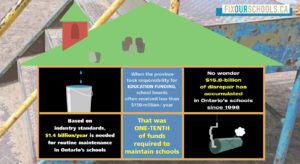 Fix Our Schools has consistently advocated for transparency; data and metrics to gauge outcomes; and adequate, stable funding to ensure that all Ontario’s publicly funded schools are safe, healthy, well-maintained and conducive to learning. Ontario’s children deserve nothing less.
Fix Our Schools has consistently advocated for transparency; data and metrics to gauge outcomes; and adequate, stable funding to ensure that all Ontario’s publicly funded schools are safe, healthy, well-maintained and conducive to learning. Ontario’s children deserve nothing less.
Premier Ford and Minister Lecce – when will you make a commitment to prioritize Ontario’s children? The clock is ticking.

